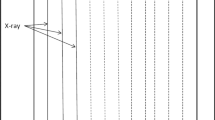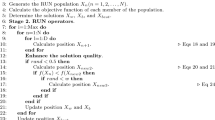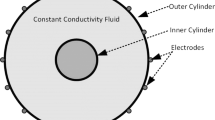Abstract
This paper presents an abdomen disease diagnostic system based on the flexi-scale curvelet transform, which uses different optimal scales for extracting features from computed tomography (CT) images. To optimize the scale of the flexi-scale curvelet transform, we propose an improved genetic algorithm. The conventional genetic algorithm assumes that fit parents will likely produce the healthiest offspring that leads to the least fit parents accumulating at the bottom of the population, reducing the fitness of subsequent populations and delaying the optimal solution search. In our improved genetic algorithm, combining the chromosomes of a low-fitness and a high-fitness individual increases the probability of producing high-fitness offspring. Thereby, all of the least fit parent chromosomes are combined with high fit parent to produce offspring for the next population. In this way, the leftover weak chromosomes cannot damage the fitness of subsequent populations. To further facilitate the search for the optimal solution, our improved genetic algorithm adopts modified elitism. The proposed method was applied to 120 CT abdominal images; 30 images each of normal subjects, cysts, tumors and stones. The features extracted by the flexi-scale curvelet transform were more discriminative than conventional methods, demonstrating the potential of our method as a diagnostic tool for abdomen diseases.




















Similar content being viewed by others
References
Polat K, Gunes S (2008) Principles component analysis, fuzzy weighting pre-processing and artificial immune recognition system based diagnostic system for diagnosis of lung cancer. Expert Syst Appl 34:214–221
Ahmad F, Isa NAM, Hussain Z, Osman MK (2013) Intelligent medical disease diagnosis using improved hybrid genetic algorithm multilayer perceptron network. J Med Syst 37:1–8
Liang C, Peng L (2013) An automated diagnosis system of liver disease using artificial immune and genetic algorithms. J Med Syst 37:1–10
Elizabeth DS, Nehemiah HK, Retmin CS, Kannan A (2010) Computer-aided diagnosis of lung cancer based on analysis of the significant slice of chest computed tomography image. IET Image Process 6:697–705
Mousa R, Munib Q, Moussa A (2005) Breast cancer diagnosis system based on wavelet analysis and fuzzy-neural. Expert Syst Appl 28:713–723
Rashed EA, Ismail IA, Zaki SI (2007) Multiresolution mammogram analysis in multilevel decomposition. Pattern Recognit Lett 28:286–292
Ferreira CBR, Borges DL (2003) Analysis of mammogram classification using a wavelet transform decomposition. Pattern Recognit Lett 24:973–982
Dua S, Acharya UR, Chowriappa P, Vinitha SS (2013) Wavelet-based energy features for glaucomatous image classification. IEEE Trans Inf Technol Biomed 16:80–89
Eltoukhy MM, Faye I, Samir BB (2010) Breast cancer diagnosis in digital mammogram using multiscale curvelet transform. Comput Med Imaging Graph 34:269–276
Chen EL, Chung PC, Chen CL, Tsai HM, Chang CI (1998) An automatic diagnostic system for CT liver image classification. IEEE Trans Biomed Eng 45:783–794
Gletsos M, Mougiakakou SG, Matsopoulos GK, Nikita KS, Nikita AS, Kelekis D (2003) A computer-aided diagnostic system to characterize CT focal liver lesions: design and optimization of a neural network classifier. IEEE Trans Inf Technol Biomed 7:153–162
Huang YL, Chen JH, Shen WC (2004) Computer-aided diagnosis of liver tumors in non-enhanced CT images. J Med 9:141–150
Dettori L, Semler L (2007) A comparison of wavelet, ridgelet and curvelet based texture classification algorithm in computed tomography. Comput Biol Med 37:486–498
Joshi M, Manthalkar R, Joshi Y (2008) Image compression using curvelet, ridgelet and wavelet transform a comparative study. In: Proceedings ICGST-GVIP. ISSN 1687-398X 8
Alzubi S, Naveed I, Maysam A (2011) Multiresolution analysis using wavelet, ridgelet, and curvelet transforms for medical image segmentation. Int J Biomed Imaging 2011:1–18
Jain R, Mazumdar J (2003) A genetic algorithm based nearest neighbor classification to breast cancer diagnosis. Australas Phys Eng Sci Med 26:6–11
Kumar SS, Devapal D (2014) Survey on recent CAD system for liver disease diagnosis. In: Proceedings ICCICCT, pp 763–766
Hameed RS, Kumar SS (2012) Assessment of neural network based classifiers to diagnose focal liver lesions using CT images. Procedia Eng 38:4048–4056
Peter D, Alexander C, Alexey T, Maria JC, Michael S, Rolf J, Michael U, Matthias H (2013) A retrieval-based computer-aided diagnosis system for the characterization of liver lesions in CT scans. Acad Radiol 20:1526–1534
Aureline Q, Ingrid M, Denis H, Gerard S, William P (2013) Assessing the classification of liver focal lesions by using multi-phase computer tomography scans. Med Content-Based Retr Clin Decis Support 7723:80–91
Mougiakakou SG, Valavanis IK, Mouravliansky NA, Nikita KS (2009) DIAGNOSIS: a telematics-enabled system for medical Image archiving, management, and diagnosis assistance. IEEE Trans Instrum Meas 58:2113–2120
Uetani M, Tateyama T, Kohara S, Tanaka H, Han XH, Kanasaki S, Furukawa A, Chen YW (2014) Statistical shape model of the liver and its application to computer-aided diagnosis of liver cirrhosis. Electr Eng Jpn 190:37–45
Gopinath B, Shanthi N (2013) Computer-aided diagnosis system for classifying benign and malignant thyroid nodules in multi-stained FNAB cytological images. Australas Phys Eng Sci Med 36:219–230
Kumar SS, Moni RS, Rajeesh J (2013) An automatic computer-aided diagnosis system for liver tumors on computed tomography images. Comput Electr Eng 39:1516–1526
Adcock A, Rubin D, Carlsson G (2014) Classification of hepatic lesions using the matching metric. J Comput Vis Image Underst 121:36–42
Kumar SS, Moni RS (2010) Diagnosis of liver tumor from CT images using curvelet transform. Int J Comput Sci Eng 2:1173–1178
Kumar SS, Moni RS (2010) Diagnosis of liver tumor from CT images using fast discrete curvelet transform. Computer aided soft computing techniques for imaging and biomedical applications, CASCT, pp 1–6
Prabha S, Sasikala M (2013) Texture classification using curvelet transform. Int J Adv Res Technol 2:249–253
Shen L, Yin Q (1990) Texture classification using curvelet transform. International symposium on information processing (ISIP-09), pp 319–324
Sahiner B, Chan HP, Petrick N (2002) Genetic algorithms for feature selection in computer-aided diagnosis. Stud Fuzziness Soft Comput 96:427–484
Ping Z, Verma B, Kumar K (2004) A neural-genetic algorithm for feature selection and breast abnormality classification in digital mammography. Proc IEEE Int Joint Conf 3:2303–2308
Soman KP, Ramachandran KI (2006) Insight into wavelets: from theory to practice, 2nd edn. Prentice-Hall, Upper Saddle River
Jemal A, Bray F, Center MM, Ferlay J, Ward E, Forman D (2011) Global cancer statistics. CA Cancer J Clin 61:69–90
Taylor DW (2010) The burden of non-communicable diseases in India. The Cameron Institute, Hamilton, ON
Gregory F, Carol S, Borofsky MS (2009) Emergency department visits and hospital admissions for kidney stone disease. In: Healthcare cost and utilization project (HCUP) statistical briefs. Agency for Health Care Policy and Research, US
Bobadilla JL, Macek M Jr, Fine JP, Farrell PM (2002) Cystic fibrosis: a worldwide analysis of CFTR mutations correlation with incidence data and application to screening. Hum Mutat 19:575–606
Candes EJ, Donoho DL (2000) Curvelets, multi-resolution representation and scaling laws wavelet applications in signal and image processing. In: Proceedings SPIE, pp 4119–01
Candes EJ, Donoho DL (1999) Ridgelets: the key to higher-dimensional intermittency? Phil Trans R Soc Lond A 357:2495–2509
Marr D, Hildreth E (1980) Theory of edge detection. Proc R Soc Lond 207(1167):187–217
Li C, Xu C, Gui C, Fox MD (2010) Distance regularized level set evolution and its application to image segmentation. IEEE Trans Image Process 19:3243–3254
Goldberg DE (1989) Genetic algorithms in search and optimization. Addison-wesley, Boston
Whitley D, Starkweather T, Bogart C (1990) Genetic algorithms and neural networks: optimizing connections and connectivity. Parallel Comput 14:347–361
Larry R (2005) Multi-objective site selection and analysis for GSM cellular network planning. Ph. D. thesis
Keki MB (2009) A unified explanation for the adaptive capacity of simple recombinative genetic algorithms. Ph.D. thesis
Lee CC, Chen SH, Chiang YC (2007) Classification of liver diseases from CT images using support vector machine. J Adv Comput Intell Intell Inf 11:396
Author information
Authors and Affiliations
Corresponding author
Rights and permissions
About this article
Cite this article
Sethi, G., Saini, B.S. Abdomen disease diagnosis in CT images using flexiscale curvelet transform and improved genetic algorithm. Australas Phys Eng Sci Med 38, 671–688 (2015). https://doi.org/10.1007/s13246-015-0389-7
Received:
Accepted:
Published:
Issue Date:
DOI: https://doi.org/10.1007/s13246-015-0389-7




